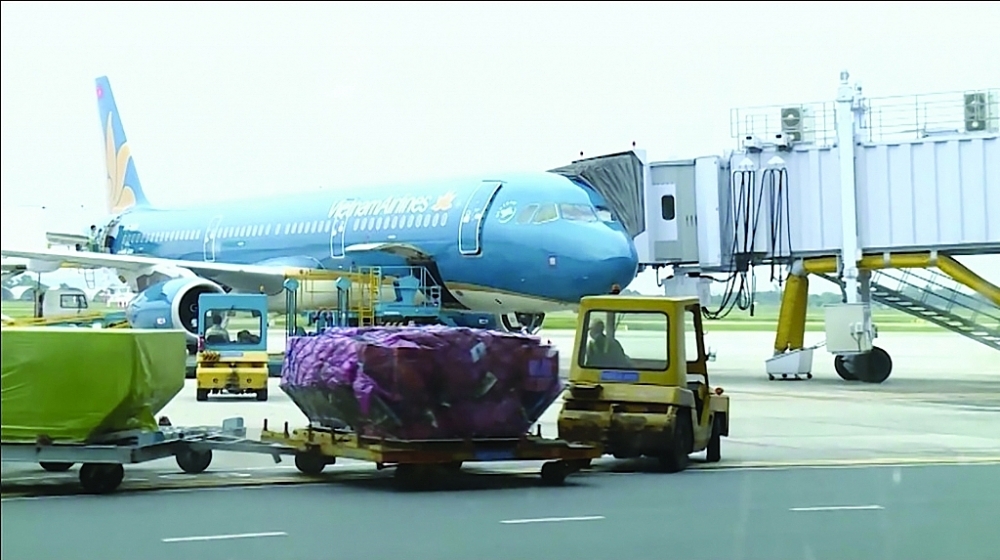 |
The Customs clearance time for each shipment fell from 3-6 hours to an average of less than 10 minutes. Photo: N.Linh |
Building a comprehensive and automated IT system
The Customs sector has applied information technology in the whole customs process for import and export goods by sea, land and railway. However, the IT application for aviation customs procedures before September 2020 has not been implemented in a comprehensive manner.
Therefore, the connection and exchange of information between Customs authorities and seaport operators, airlines, importers and exporters still show limitations, leading to difficulties in tracking and management of import and export, prolonging the storage time and increasing costs.
The management method is based on checking paper customs records and manual supervision, making it difficult to meet the requirements of customs management in the context of increasing workload and reducing Customs officers.
Deputy Director of Hanoi Customs Department Hoang Quoc Quang said that implementing the Government’s policy on implementing the key tasks and solutions to improve the business environment and enhance competitiveness in 2020 and Customs Development Strategy for 2020, Hanoi Customs Department proposed and was assigned by the Ministry of Finance and General Department of Vietnam Customs to pilot implementation of the National Single Window System and the Automated System for Customs Management at Noi Bai International Airport.
Based on the results achieved after more than two years of pilot implementation (from October 2017), on September 28, 2020, the Minister of Finance issued Decision No. 1475/QĐ-BTC on the official launch of the National Single Window System and the Automated System for Customs Management at Noi Bai International Airport Customs Branch.
The official operation of the two systems has changed the management method at Noi Bai International Airport, improved the efficiency of state management and enhanced the reputation of Vietnam Airlines and Vietnam Customs in the world, which is the basis for expanding the systems at international airports nationwide.
After more than two years of official implementation (from September 2020 to October 2022), the systems have met the goals and requirements with outstanding results.
According to a representative of Noi Bai International Airport Customs Branch, the systems have ensured the modernization and IT application in customs procedures; and improved the efficiency of customs inspection, management and supervision.
100% of airlines have sent information to the National Single Window, and processed customs clearance for more than 54,000 international flights on the system. The Automated System for Customs Management has connected all airport warehouses at Noi Bai International Airport, and supervised over 2.5 million shipments. The stable operation rate of the system reached over 99.5%. Therefore, the clearance time for each shipment is reduced from 3 to 6 hours to an average of less than 10 minutes.
It only takes from five to ten minutes to supervise each imported consignment from entering the customs control area to exiting the area without depending on the volume of means of transport, goods in and out of the warehouse and customs declarations.
Currently, goods brought in, taken out, and stored at the three airports are strictly controlled to ensure that all shipments are tracked and managed automatically on the system. The time for customs clearance and release of goods is much shorter than before.
Bringing benefits for three parties
The official operation of the system has brought great benefits to Customs and airlines, businesses and people. Deputy Director Hoang Quoc Quang said that the system has changed the management method of the Customs, shifting from checking paper customs dossiers and manual supervision into a modern management method based on the advanced IT system, and connected data among three stages before, during customs clearance and inspecting goods across the customs control area, ensuring automatic management and supervision of goods in and out the warehouse.
Through the automated receipt and processing of e-data before the flight, the system allows the Customs to identify risks to apply risk management, monitor and screen goods, thereby preventing and promptly handling smuggling and commercial fraud, and contributing to protecting national security.
The system allows warehouse operators and airlines to connect and exchange information online with Customs instead of submitting paper documents and dossiers, saving time, costs, and human resources, and improving the competitiveness and efficiency of their business operations.
In addition, the two systems meet standards in line with international practices on the connection between Customs authorities and aviation operators. At the same time, they help strengthen the initiative in management, statistics, keeping documents and books, providing information and data of goods; providing full information related to the customs clearance permit for each shipment in and out the warehouse to the warehouse operators.
Especially, the Automated System for Customs Management creates maximum favorable conditions for businesses in import-export activities, helping import-export businesses save time, moving and warehousing costs, and improving economic efficiency.
The system creates an online public service environment, allowing businesses to interact with the system anytime, anywhere, quickly and accurately. It also improves the transparency of the customs process, and minimizes face-to-face communication of import-export enterprises with the customs in certifying goods across the customs control area.
According to a representative of Hanaro TNS Vietnam Co., Ltd., after two years of implementing the system, the customs clearance and supervision time has seen positive results. The improvement of the Automated System for Customs Management has reduced a lot of paperwork-related procedures, and saved time, costs and human resources in performing supervision procedures at Noi Bai International Airport. Keeping paper documents for goods that have passed the control area is not required when the import-export enterprises can look up information on the Customs system, helping them to have better control in the management of import and export goods.
